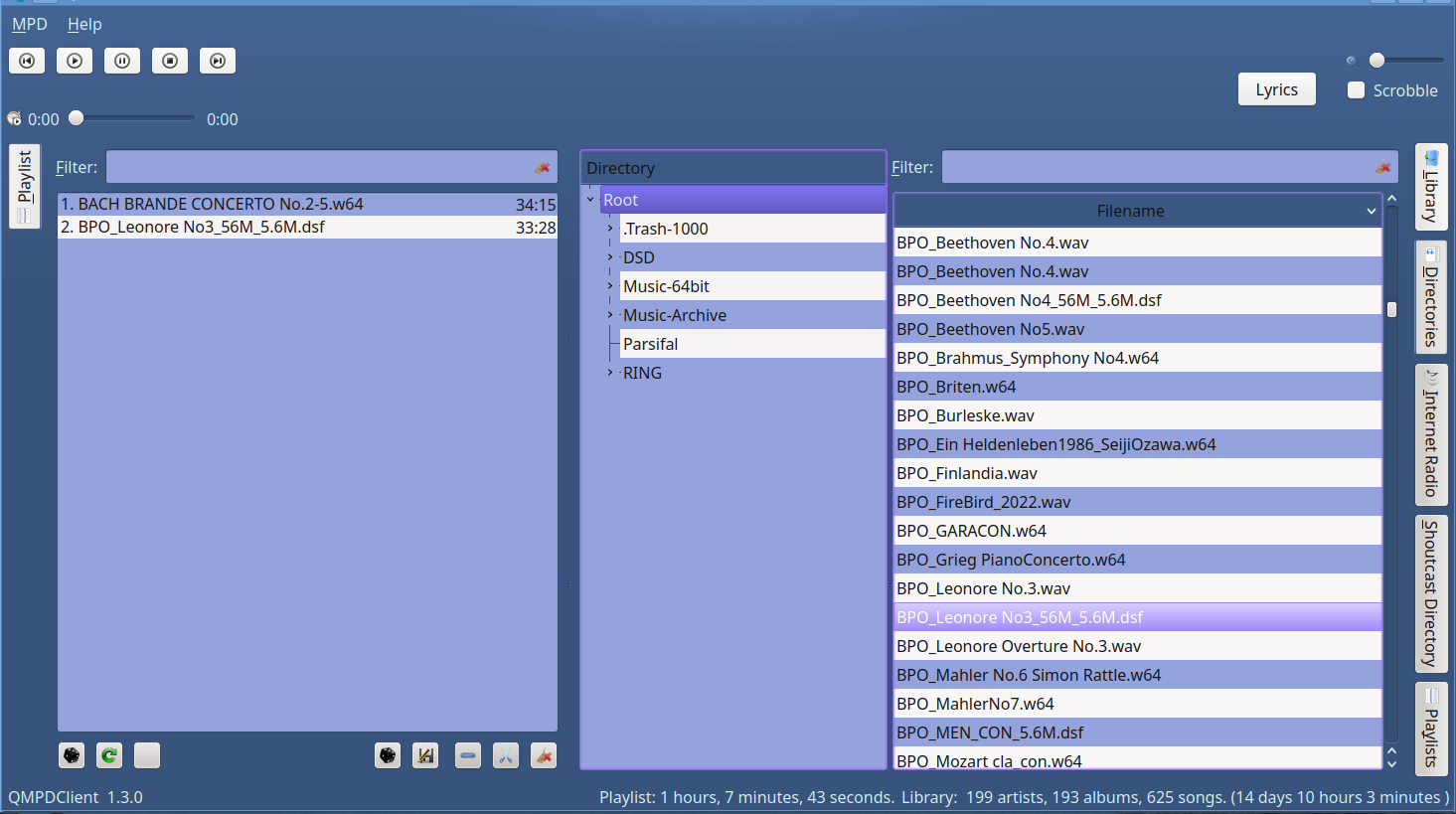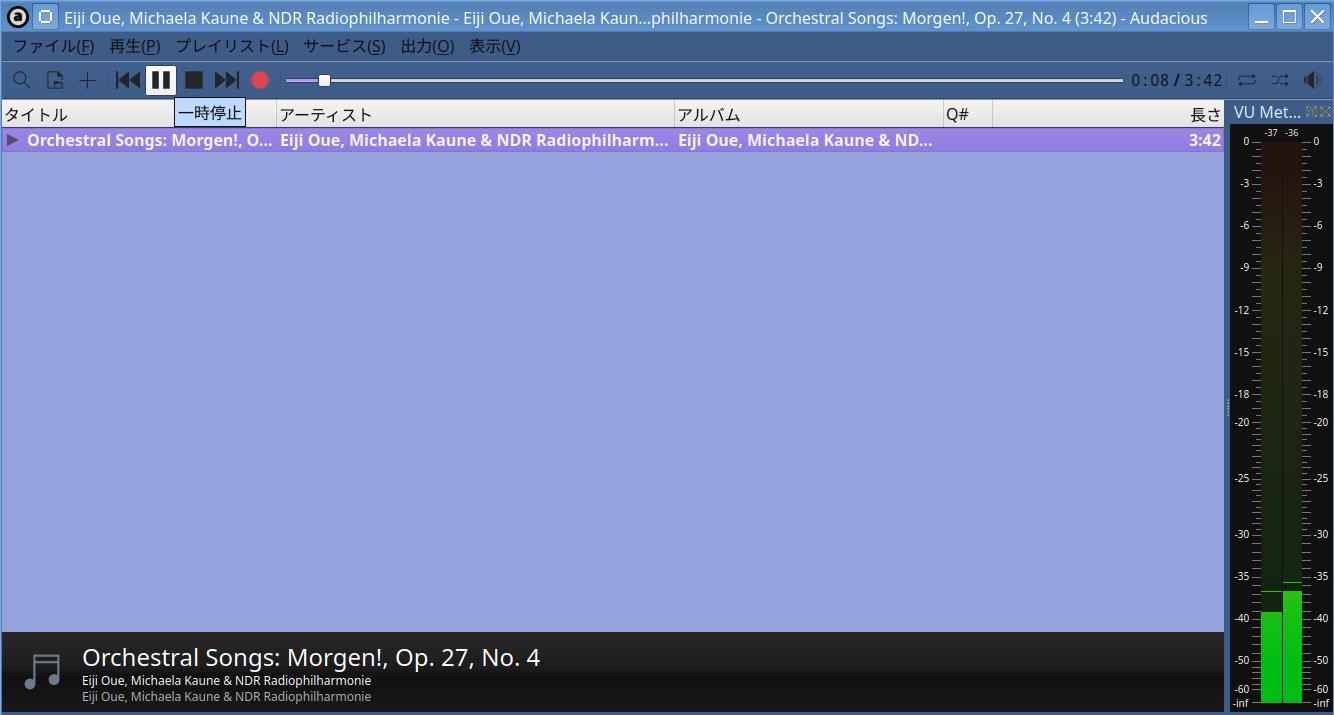
UbuntuStudio 24.04でPCMやDSDのハイレゾソースを聞くためにはalsa+MPD+PlayerClientが必須です。alsaはデフォルトのままですが、MPDとPlayerはインストールする必要があります。alsaはカーネルサウンドデバイスのドライバーです。MPDはmusic player daemon の略でデーモンとして動作します。MPDをGUIで操作するためのインターフェイスがQMPDClientです。開発は1.30で止まっていますが、w64ファイルとDSDのDSFとDFFをネイティブ再生でき、PDSでソースを公開しているのはQMPDClientだけです。ビルドにはQt5以上のフレームワークが必要です。
それほど神経質になることでもないのですが、PCからDACへのUBS経由のmusic data転送にはエラー訂正のないプロトコルが使われるのでUSBケーブルは高品質のなるべく短いものを使用する方が良いようです。
クラッシックを聞く方はおそらくフルセットの部屋で楽しむ方が多いのでNASなどのネットワークプレイヤーは必要ないと思います。内蔵SSDや外付けUSB接続の方がLAN経由よりはるかに音がいいですし音飛びもほぼ無いです。
高級なオーディオ機器と並べてもデザインで遜色ないMAC MINIにUbuntu StudioをインストールしてQMPDClientとMPDで鳴らしています。macOSのMontreyより動作が軽快ですし、様々な制約のない分、ストレスがないからです。
DSDのメリットはPCMと同等のハイレゾではファイルサイズが半分ほどで済むところです。商用ストリーミングや音源ダウンロード販売に適しています。SACDの規格もCD容量にハイレゾ音源を収めるために開発されたのでしょう。DSDの再生音に透明さが感じられるのはノイズフィルタリングの為で、そのせいか再生音は3%程度音量が落ち、PCMに比べて音場の広がりが狭く聞こえます。ジッターノイズ処理アルゴリズムが倍音もノイズとして処理しているからでしょうか。PCMをDSDに変換するとピアノやファゴットの高音域の共振音が抑えられるようです。
Audacity というマルチプラットホームのソフトでハイレゾPCM音源が簡単に作れます。CDをクリッピングするよりloopback録音でwav音源化した方が音質が遥かに良いです。コロナ禍でコンセルトヘボウやベルリン・フィルがエンプティコンサートをウェブで公開していたのでかなりの良質の録音を入手できました。コンセルトヘボウとフィルハーモニーザールの音響の違いがよくわかります。
MPDはUbuntuのレポジトリーにあるので apt install mpd でインストールできます。
/etcのmpd.confをホームディレクトリに.mpdディレクトリを作りコピーします。
〜〜〜〜〜〜〜〜〜〜〜〜〜〜〜〜〜〜〜〜〜〜〜〜〜〜〜〜〜〜〜〜〜〜
music_directory “/home/user/musicディレクトリ”
#
# This setting sets the MPD internal playlist directory. The purpose of this
# directory is storage for playlists created by MPD. The server will use
# playlist files not created by the server but only if they are in the MPD
# format. This setting defaults to playlist saving being disabled.
#
playlist_directory “/home/user/.mpd/playlists”
#
# This setting sets the location of the MPD database. This file is used to
# load the database at server start up and store the database while the
# server is not up. This setting defaults to disabled which will allow
# MPD to accept files over ipc socket (using file:// protocol) or streaming
# files over an accepted protocol.
#
db_file “/home/user/.mpd/tag_cache”
# These settings are the locations for the daemon log files for the daemon.
#
# The special value “syslog” makes MPD use the local syslog daemon. This
# setting defaults to logging to syslog.
#
# If you use systemd, do not configure a log_file. With systemd, MPD
# defaults to the systemd journal, which is fine.
#
#log_file “/var/log/mpd/mpd.log”
# This setting sets the location of the file which stores the process ID
# for use of mpd –kill and some init scripts. This setting is disabled by
# default and the pid file will not be stored.
#
# If you use systemd, do not configure a pid_file.
#
pid_file “/home/user/.mpd/pid”
# This setting sets the location of the file which contains information about
# most variables to get MPD back into the same general shape it was in before
# it was brought down. This setting is disabled by default and the server
# state will be reset on server start up.
#
state_file “/var/lib/mpd/state”
#
# The location of the sticker database. This is a database which
# manages dynamic information attached to songs.
#
##sticker_file “/var/lib/mpd/sticker.sql”
#
###############################################################################
# General music daemon options ################################################
#
# This setting specifies the user that MPD will run as. MPD should never run as
# root and you may use this setting to make MPD change its user ID after
# initialization. This setting is disabled by default and MPD is run as the
# current user.
#
user “user”
~~~~~~~~~~~~~~~~~~~~~~~~~~~~~~~~~~~~~~~~~~~~~~~~
# Audio Output ################################################################
#
# MPD supports various audio output types, as well as playing through multiple
# audio outputs at the same time, through multiple audio_output settings
# blocks. Setting this block is optional, though the server will only attempt
# autodetection for one sound card.
#
# An example of an ALSA output:
#
audio_output {
type “alsa”
name “DACの名称”
device “hw:DAC” # aplayコマンドで接続しているDAC名を確認する
mixer_type “hardware” # optional
## mixer_device “default” # optional
## mixer_control “PCM” # optional
## mixer_index “0” # optional
}
#
〜〜〜〜〜〜〜〜〜〜〜〜〜〜〜〜〜〜〜〜〜〜〜〜〜〜〜〜〜〜〜〜〜〜〜〜#
AudaciousもすばらしいPlayerですが、DSDのネイティブ再生が出来ません。DSFファイルは読めますがDACへの出力はPCMで表示されます。

